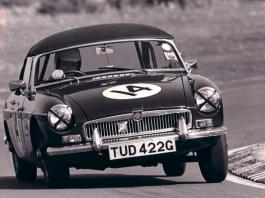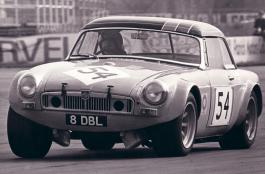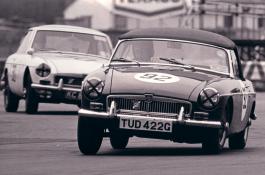Successful
club racing series that began over 36 years ago

Victor Smith with "TUD" brushing the fast apex
after Coram at Snetterton in a BRSCC Prodsports event in September
1976. (Photo: Fred Scatley)
The BCV8 Championship has been one of the most successful Club
based motor racing series and continues to thrive by providing
close racing with full grids at a relatively low cost. For over thirty
years, BCV8 enthusiasts have been a group clearly set on enjoying
both the fun on
and off the circuit - with some notable offs one should
add! The annual dinners in the early years were
some
of the most lively and
enjoyable
|
Page
1
social events you could have attended and that spirit and sense of
fun clearly continues today. The BCV8 Championship was formed back
in 1974 within the MG Car Club by Barry Sidery-Smith and Victor Smith,
two longstanding members of the Club, at a time when T Type and MGA
racing was on a high and providing close, entertaining motor sport
for competitors and spectators alike.
So what was behind the creation of the new championship for MGBs,
MGCs and V8s at that time? Simply that the better performance
of other makes of more modern sports cars was leaving BCV8 models
behind and the rapid growth of sponsorship was raising car preparation
budgets dramatically in most national sports car racing formulae.
The MGB enthusiast needed a competition series which provided close
racing at a more affordable cost - so the BCV8 Championship was formed
by members of the MG Car Club. Here Victor Smith (BCV8 Secretary
1974-77 and co-founder of the championship) recalls how it all started
and remembers some of the characters at the time. |
The
MGB had been a popular and affordable sports car for motor sports
enthusiasts in its early years in the sixties. Its safe and predictable
handling had encouraged many enthusiasts to enter club circuit racing
events, sprints and hillclimbs. The Abingdon Factory provided encouragement
both with the Works team cars it prepared and entered in events through
its competitions department and from the support it provided club
enthusiasts through the availability of competitions parts and advice
through Special Tuning. The successes with the MGB and MGC in national
and international competitions in the sixties and early seventies
are legendary - for example the Monte Carlo Rally in 1964, at Brands
Hatch in the Guards 1,000 miles race in 1965, Sebring in 1968 and
the hat trick of singleton entries at le Mans in 1963, 1964 and 1965
which Peter Browning reckoned were the last true sports cars to run
at the Sarthe circuit. Those successes were achieved in the hands
of talented drivers like Paddy Hopkirk, Timo Makinen, John Rhodes,
Andrew Hedges and Clive Baker to name but a few. At a club level,
many stalwarts in our Club today were campaigning their MGBs in the
early years - people like Anthony Binnington, Warwick Banks, Terry
Osborne and the irrepressible Barry Sidery-Smith. But by the mid seventies,
the MGB and its variants had become less and less competitive in both
modified and standard classes as more modern machinery like the better
handling rear engined Lotus Europa, the nimble Davrian and the more
powerful TVRs began to dominate national sports car events.
In the modified classes, MGB campaigners tried using more rubber
in an attempt to increase cornering speeds and grip and ungainly flared
arches started to sprout on classic works cars like |
Page
2

The ex-Works
8 DBL in action with Ian Polley at Silverstone in May 1974 illustrates
how wheel arch flares and extra rubber were used in an attempt to
remain competitive with more modern fully modified prodsports cars
at that time. (Photo: Fred Scatley)
It
became only too evident that the MGB was becoming less and less competitive
in fully modified competition
8 DBL. The car had been acquiredby Ian Polley from Charles Dawkins
as the ex Anthony Bamford works car. Ian Polley, a Club enthusiast,
had graduated through both Club and BRSCC Prodsports events. We restored
8 DBL together in 1973 still in its JCB livery - but at least the
bright yellow car could be seen in competitors' mirrors! It was remarkable
how the MGB could be developed in those ways but it became only too
evident that the MGB was becoming less and less competitive in fully
modified competition. |
In standard sports car events, the MGB gradually slipped to being
a middle order car, even in well regulated and friendly championships
like the BRSCC Prodsports series run by Peter Browning at the BRSCC.
He was later the MG Car Club's competitions director.

Your first race is always something you remember
- the unfamiliar sensation of pushing a car to its limits and the
inevitable process of learning track skills. Mine was at the Club's
annual meeting at Silverstone in May 1973, seen here rounding the
old Woodcote Corner on the Club Circuit. (Photo: Fred Scatley)
In less than two seasons we went from one or two standard
cars being towed to the circuit, to a situation where only two cars
were being driven to events
In the mid seventies, the factor which was the final motivator
for forming a championship for the MGB and its variants was the rapid
increase in sponsorship, particularly support for competitors
in club based series like the BRSCC Prodsports championship. The annual
budget you needed to remain competitive in that series grew at an
alarming rate. In less than two seasons we went from one or two standard
cars being towed to the circuit, to a situation where only two cars
were being driven to events - they were a TR6 and my MGB. I recall
sitting |
Page
3
with John Britten
at a meeting at Oulton Park in the summer of 1973, where he was campaigning
an Arkley prepared Morgan V8. He complimented me on my efforts to
keep up with the pack but acknowledged I had to drive with a view
to getting home again that evening! The railway sleepers hiding behind
their ivy cladding at Oulton were certainly an unforgiving boundary
to a modest run off area! But increasing sponsorship money also had
other effects - engine blueprinting and team mechanics.
By mid 1973 blueprinting had become almost a basic necessity in
prodsports racing and some competitors also had large teams of mechanics
and support equipment in the paddock. The sight of Chris Meek sweeping
in just before practice whilst a large team of mechanics swarmed over
his Lotus Europa from just after dawn was a source of wonderment and
dismay for the truly amateur, unsponsored competitor at that time
I can tell you! The reality was national club sports car racing had
made a quantum leap, raising the annual costs for existing competitors
and creating a much higher threshold for new entrants to climb over
to be on the bottom rung of competitiveness. Many of the active characters
at the time felt something had to be done - people like Terry Osborne,
John Targett, Ricky Podmore, David Strange, Peter Chowne and John
Carter come to mind, and of course Barry Sidery-Smith.
The regulations for the BCV8 Championship were drafted as I sat
in the Old Ship at Mortlake, opposite the finishing line of the
annual boat race, with the help of Vic Ellis, Roy McCarthy and Rob
Innes-Ker who were active MGA racers at that time. Come to think of
it Rob is still racing even now, but sponsored by Age Concern if I
am not mistaken! For the first season I had just two classes - standard
and modified. Of course "standard" |
was
an open debating point from the start but the spirit of the regulations
for standard cars was they should be "as they left the factory
production line".
During the first two years it became clear that a third class was
needed to cover the increasingly quick "standard" cars
resulting in the inevitable creep from subtle, and sometimes not so
subtle, interpretations of the regulations. So we decided to create
a road-going modified class with the only constraint that those cars
had to be taxed and insured for the road, on road tyres and, most
important, they had to be driven to the circuit. The good spirit amongst
competitors resulted in very few disputes or crises in those early
years with the exception of an indecently quick space framed BV8GT
which burst on the scene for a short while in 1976 to the disgust
of many competitors. My job as the first BCV8 Secretary had been to
get the championship going whilst enjoying competing in some standard
class events too! On selling my standard MGB to the late Peter Malimson
in 1977, I handed over the role of secretary to Rob Gill from the
Lincolnshire Centre. He was an example of a Club member who had come
into motor sport through the BCV8 Championship and had successfully
campaigned an MGC Roadster. Along with Vic Young, he did a great deal
to moderate some of the less than flattering bar room jokes of the
MGC as a nose heavy rocket!
During
the first two years it became clear that a third class was needed
to cover the increasingly quick "standard" cars
BCV8 Championship
winners in the early years included David Franklin in a standard
MGBGTV8 at a time when he was a very successful leading light in the
RAC national hill climb and sprint championships in his ex Formula
2 racing car. His V8 was usually entered as his "wife's shopping
car" and was always driven to the circuit and on arrival could
easily have entered a concours event. But once in the paddock, the
rubber bumpers were stripped and in the hands of David's deceptively
quick and smooth driving style, it then became a most competitive
machine. Probably one of the most memorable spectacles in the late
seventies at wet Silverstone meetings (and what a series a wet ones
we had at that time!) was the sight of David's brilliance in the wet,
trouncing the fully modified cars. His car seemed to go round the
old Woodcote Corner in front of the stands at speeds in the wet which
were breathtaking and demonstrated his uncanny knack of driving on
the edge.
Peter Chowne, a former standard class champion in the early
years, reflected recently that one aspect of the Championship which
encouraged standard class competitors and all-rounders was that speed
events also counted for championship points. So it was possible to
do very well by combining the cheaper hillclimbs and sprints with
circuit racing. He feels that the BCV8 Championship may have been
one of the fairest championships ever devised. Even with a standard
car, providing one was prepared to travel around the country and enter
all events, it was possible to win the Championship without ever |
Page
4
winning a race! Peter
won the standard class one year this way. The 1970s were glorious
years of a fair competition but in the early 1980s "standard
cars" were going very quickly which he did not feel was entirely
the result of driver skill. One year Peter went into the roadgoing
modified class with a balanced engine, stage 2 head, 1.75 SUs and
a 740 cam and could only just about keep up with leading contenders!
He has little doubt blue-printing had become widespread and increasing
sponsorship finally drove many competitors out. Nonetheless Peter
had five glorious years of competition with memories of fellow competitors
from varied professions and backgrounds. He also recalls the Donnington
Six Hour race where the BCV8 team ran and many invitation races competing
against Morgans and TRs with success, particularly at Brands and Cadwell
which suited his MGB without an overdrive.
The MGBV8 has played a major part in the spectator value of the
BCV8 series over the last ten years and the powerful full-house
machines of Malcolm Beer and Warwick Banks to name but two have raised
the performance envelope substantially. But the V8 has not eclipsed
the 1800 based machines, and modified MGB racing is as close and exciting
as ever with characters like Anthony Binnington still campaigning
his old "OMO" machine. The standard class racing today is,
to is to my eye, extraordinarily good in that the cars frequently
run within inches of each other whereas in the mid seventies we felt
being within two cars' lengths seemed very close indeed!
But successful championships do not need to rely on their past
glories - today the MG Car Club's BCV8 Championship has some of
the closest racing you could wish to see and is as popular as ever.
I attended the 25th annual BCV8 Dinner in 1998 organised by Pam McCarthy
and found the room packed with BCV8 enthusiasts - not only the older
members but most important younger competitors and their friends.
The MGB is still an affordable sports car for club racing and the
spares suppliers have created an availability of parts which is as
good as ever. The atmos-phere at that dinner was as convivial as any
of the annual BCV8 dinners at the Bookham Grange in the early years,
although with less bun throwing, soda siphon attacks and whip-rounds
to keep the waitresses going under adverse conditions! Maybe the most
telling comment that evening was from the guest speaker Rob Gravett,
the successful production saloon car racer, who gave heart felt thanks
to the BCV8 Championship for having provided him with a way of entering
motor racing and learning the basic skills in a friendly and affordable
club based series.
Yes the BCV8 Championship is very much alive today
and thriving, and above all it is respected and valued as an exceptionally
well run, club based series in an increasingly professional motor
sport world.
©
Victor Smith |
|
